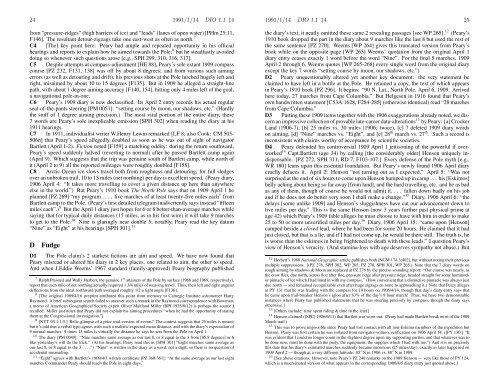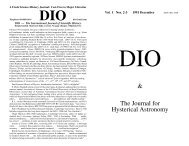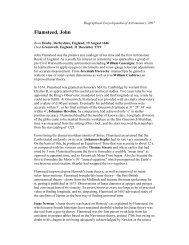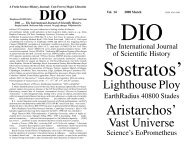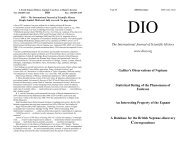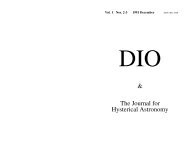DIO 1.1 - DIO, The International Journal of Scientific History
DIO 1.1 - DIO, The International Journal of Scientific History
DIO 1.1 - DIO, The International Journal of Scientific History
Create successful ePaper yourself
Turn your PDF publications into a flip-book with our unique Google optimized e-Paper software.
24 1991/1/14 <strong>DIO</strong> <strong>1.1</strong> ‡4<br />
from “pressure-ridges” (high barriers <strong>of</strong> ice) and “leads” (lanes <strong>of</strong> open water) [PHm 25:11,<br />
F146]. <strong>The</strong> resultant detour-zigzags take one east-west as <strong>of</strong>ten as north. 7<br />
C4 [<strong>The</strong>] key point here: Peary had ample and repeated opportunity in his <strong>of</strong>ficial<br />
hearings and reports to explain how he aimed towards the Pole; 8 but he steadfastly avoided<br />
doing so whenever such questions arose [e.g., SPH 299, 310, 316, 317].<br />
C5 Despite attempts at compass-adjustment [HE 88], Peary’s sole extant 1909 compass<br />
course [PZ 232, F131, 138] was <strong>of</strong>f by about 8 degrees; and from various such aiming<br />
errors (as well as detouring and drift), his previous shots at the Pole lurched hugely left and<br />
right, misaimed by about 10 to 15 degrees [F135]. But in 1909 he alleged a straight-line<br />
path, with about 1 degree aiming accuracy [F140, 154], hitting only 4 miles left <strong>of</strong> the goal,<br />
a navigational pole-in-one.<br />
C6 Peary’s 1909 diary is now declassified. Its April 2 entry records his actual regular<br />
seat-<strong>of</strong>-the-pants steering [PM 0051]: “setting course by moon, our shadows, etc.” (Hardly<br />
the stuff <strong>of</strong> 1 degree aiming precision.) <strong>The</strong> most vital portion <strong>of</strong> the entire diary, these<br />
7 words are Peary’s sole inexplicable omission [SPH 302] when reading the diary at his<br />
1911 hearings.<br />
C7 In 1911, individualist writer W.Henry Lewin remarked [LF 8; also Cook: CM 505-<br />
506n] that Peary’s speed allegedly doubled as soon as he was out <strong>of</strong> sight <strong>of</strong> navigator<br />
Bartlett (April 1-2). Fiction noted [F159] a matching oddity: during the return southward,<br />
Peary’s speed suddenly halved (reverting to normal) after he passed Bartlett camp again<br />
(April 9). Which suggests that the trip was genuine south <strong>of</strong> Bartlett camp, while north <strong>of</strong><br />
it (April 2 to 9) all the reported mileages were roughly doubled [F158].<br />
C8 Arctic Ocean ice slows travel both from roughness and detouring; for full sledges<br />
over an unbroken trail, 10 to 15 miles (net northing) per day is excellent speed. (Peary diary,<br />
1906 April 4: “It takes more travelling to cover a given distance up here than anywhere<br />
else in the world.”) But Peary’s 1910 book <strong>The</strong> North Pole says that on 1909 April 1 he<br />
planned [PZ 269] “my program . . . . five marches <strong>of</strong> at least twenty-five miles each” from<br />
Bartlett camp to the Pole. (Peary’s first detailed telegram inadvertently says instead “fifteen<br />
miles each”.) 9 But the April 1 diary just hopes for 6 or 8 better-than-average marches while<br />
saying that for typical daily distances (15 miles, as in his first wire) it will take 9 marches<br />
to get to the Pole. 10 Nine is glaringly near double 5; notably, Peary read the key datum<br />
“Nine” as “Eight” at his hearings [SPH 301]. 11<br />
D<br />
Fudge<br />
D1 <strong>The</strong> Pole claim’s 2 starkest fictions are aim and speed. We have now found that<br />
Peary misread or altered his diary in 2 key places, one related to aim, the other to speed.<br />
And when J.Eddie Weems’ 1967 standard (family-approved) Peary biography published<br />
7 Ralph Plaisted and Wally Herbert, the genuine 1 st attainers <strong>of</strong> the Pole by surface (1968 and 1969, respectively),<br />
report that each mile <strong>of</strong> net northing actually required 1 3/4 miles <strong>of</strong> weaving travel. Thus, their left and right angular<br />
deflections from the ideal northward path averaged roughly 1/2 a right angle [F136].<br />
8 [<strong>The</strong> original 1989/4/16 preprint attributed this point from memory to Carnegie Institute astronomer Harry<br />
Raymond. A brief subsequent search failed to uncover such a remark in the Raymond correspondence with Bowman;<br />
a memo <strong>of</strong> American Geographical Society expert Oliver Maitland Miller (BPJ 1935/8/12) is perhaps the source I<br />
recalled. Miller just notes that Peary did not explain his aiming procedures “when he had the opportunity <strong>of</strong> stating<br />
them at the Congressional investigation.”]<br />
9 [NYT 9/11:1:5.] Relic-glimpse <strong>of</strong> a prior trial-version <strong>of</strong> events? <strong>The</strong> context suggests that 25 miles is meant;<br />
but it’s odd that a verbal typo agrees with such a realistic expected mean distance, and with the diary’s expectation <strong>of</strong><br />
9 normal marches: 9 times 15 miles is virtually the distance he says he was from the Pole on April 1.<br />
10 <strong>The</strong> diary [PM 0049]: “Nine marches same average as our last 8, or 8 equal to the 3 from [85.8 degrees] or 6<br />
like yesterday’s will do the trick.” (At his hearings, Peary read this as [SPH 301] “Eight marches same average as<br />
our last 8, or 8 equal to the 3 . . . .”) “Nine” is written in the diary as a word, not a digit; so there is no question <strong>of</strong><br />
accidental misreading.<br />
11 “Eight” agrees with Bartlett’s 1909/4/1 written certificate [PZ 360-361]: “At the same average as our last eight<br />
marches Commander Peary should reach the Pole in eight days.”<br />
1991/1/14 <strong>DIO</strong> <strong>1.1</strong> ‡4 25<br />
the diary’s text, it neatly omitted these same 2 revealing passages [see WP 265]. 12 (Peary’s<br />
1910 book dropped the part in the diary about 9 marches like the last 8 but used the rest <strong>of</strong><br />
the same sentence [PZ 270]. Weems [WP 264] gives this truncated version from Peary’s<br />
book while on the opposite page [WP 265] Weems’ quotation from the original April 1<br />
diary entry ceases exactly 1 word before the word “Nine”. For the final 5 marches, 1909<br />
April 2 through 6, Weems quotes [WP 265-268] every single word from the original diary<br />
except the key 7 words “setting course by moon, our shadows, etc.”)<br />
D2 Peary unquestionably altered yet another key document: the very statement he<br />
claimed to have left in a bottle at the Pole. He retained a copy, the text <strong>of</strong> which appears<br />
in Peary’s 1910 book [PZ 296]. It begins: “90 N. Lat., North Pole, April 6, 1909. Arrived<br />
here today, 27 marches from Cape Columbia.” But Helgesen in 1916 found that Peary’s<br />
own handwritten statement [C53A:1628, F284-285] (otherwise identical) read “28 marches<br />
from Cape Columbia.”<br />
D3 Putting these 1909 items together with the 1906 exaggerations already noted, we discern<br />
an impressive collection <strong>of</strong> provable late-career data-alterations 13 by Peary: [a] Crocker<br />
Land (1906-7), [b] 25 miles vs. 30 miles (1906; twice), [c] 7 deleted 1909 diary words<br />
on aiming, [d] “Nine” marches vs. “Eight”, and [e] 28 th march vs. 27 th . Such a record is<br />
inconsistent with claims worthy <strong>of</strong> acceptance by scientific societies.<br />
D4 Peary defended his controversial 1909 April 1 jettisoning <strong>of</strong> the powerful if overworked<br />
14 Capt.Bartlett (age 34) by calling [the considerably older] Henson uniquely indispensable.<br />
[PZ 272, SPH 311, RD 7, F103-107.] Every defense <strong>of</strong> the Pole myth [e.g.,<br />
WR 180] leans upon this essential foundation. But Peary’s newly found 1906 April diary<br />
cruelly defaces it. April 2: Henson “not turning out as I expected.” April 5: “Was not<br />
surprised at the end <strong>of</strong> six hours to come upon Henson humped up in camp . . . his [Eskimos]<br />
belly aching about being so far away [from land], and the hard travelling, etc. and he as bad<br />
as any <strong>of</strong> them, though <strong>of</strong> course he would not admit it. . . . fallen down badly on his job<br />
and if he does not do better very soon I shall make a change.” 15 Diary, 1906 April 6: “the<br />
delays [some unlike 1909] and Henson’s sluggishness have cut our advancement down to<br />
five miles per day.” This is the same Henson (now 3 years further past physical prime at<br />
age 42) which Peary’s 1909 fable alleges he must choose to have with him in order to make<br />
25 to 50 or more unverified miles per day. 16 Diary, 1906 April 15: “came upon [Henson]<br />
camped beside a closed lead, where he had been for some 20 hours. He claimed that it had<br />
just closed, but that is a lie, and if I had not come up, he would be there still. <strong>The</strong> truth is, he<br />
is worse than the eskimos in being frightened to death with these leads.” I question Peary’s<br />
view <strong>of</strong> Henson’s veracity. (And stamina-loss with age deserves sympathy not abuse.) But<br />
12 Herbert’s 1988 National Geographic article publishes both [NGM 174.3:402], but without noting their previous<br />
multiple suppressions. [(PZ 276, SPH 302, WP 265; PZ 270, SPH 301, WP 265.) Note that the 7 diary words on<br />
rough aiming by shadows & Moon are replaced at PZ 276 by the precise-sounding report: “Our course was nearly, as<br />
the crow flies, due north, across floe after floe, pressure ridge after pressure ridge, headed straight for some hummock<br />
or pinnacle <strong>of</strong> ice which I had lined in with my compass.” (How convenient that a distinctive pinnacle was always just<br />
due north — and remained recognizable even after huge zigzags en route to approaching it.) Note that Peary alleges<br />
at PY 131 that he was leading with the compass for 10 hours on 1906/4/14, though that day’s diary entry says that<br />
he came upon trail-breaker Henson’s igloo after 83% <strong>of</strong> the day’s 9 hour march! Thus, we have two demonstrable<br />
instances where Peary has published statements that he was steering precisely by compass, though the diary says<br />
otherwise.]<br />
13 [Others include: time spent riding & time in the lead.]<br />
14 Henson claimed ([SPC] 1926/6/11) that Bartlett was worn out. (Peary had made Bartlett break most <strong>of</strong> the 1909<br />
March trail.)<br />
15 This was to prove impossible since Peary had lost contact with all non-Eskimo members <strong>of</strong> the expedition but<br />
Henson. Peary was first certain he was isolated from navigator-witness verification on 1906 April 14. ([PY 130:] “It<br />
was evident that I could no longer count in the slightest degree upon my supporting parties, and that whatever was to<br />
be done now, must be done with the party, the equipment, the supplies which I had with me.”) And it is on precisely<br />
this date that his diary’s estimated marches suddenly became enormous (25 miles/day), exactly as later happened on<br />
1909 April 2 — though at a very different latitude: 85 ◦ N in 1906 vs. 88 ◦ N in 1909.<br />
16 [See above citations. However, note Peary’s PZ 240 remarks on the 1909 Henson — very like those <strong>of</strong> PY 124,<br />
which is a much-muted version <strong>of</strong> what appears in the corresponding 1906/4/5 diary entry just quoted above.]


